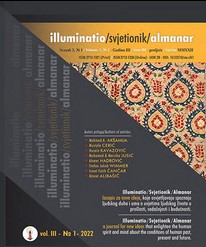QADAR/SINA´AT – KARAKTERIZACIJA NEKIH SUŠTINSKIH OKCIDENTALNOVESTERNIZIRANIH POGLEDA NA TRADICIONALNI ISLAMSKI KREATIVNI IZRAZ
QADAR/SINA´AT – CHARACTERIZATION OF SOME ESSENTIAL OCCIDENTAL-WESTERNIZED VIEWS ON TRADITIONAL ISLAMIC CREATIVE EXPRESSION
Author(s): Mehmed A. AkšamijaSubject(s): Cultural history, Visual Arts, Aesthetics, History of Islam, Globalization, History of Art
Published by: Centar za dijalog - Vesatijja
Keywords: Ìslām; Islamic civilization; Islamic culture; art; homo islamicus; qadar/ṣināʿat; globalization of culture;
Summary/Abstract: The intention of this analysis is to continue the discussion (from the previous issuees) of some parts of the history of what is declared or titled „Islamic art”, within the critical and theoretical framework of both OccidentalWestern and (some) Muslim perspectives. The analysis and establishments of limits in line with the prevailing authorities will contribute to the vital modalities of qadar/ṣināʿat discourse which are resolutely Islamic and in line with their source (ar. al-marjaʿ or al-maṣdar). Particular attention is drawn to advocating differences, due to Occidental-westernized academic efforts to ignore the spirit of unity and the self-reflective Islamic constants of qadar/ṣināʿat discourses and impose the artificial dichotomy of the sacral and profane, and due to paradigmatic views on the evaluation of the aestheticized achievement of the originator/designer of representation, (i.e. homo islamicus) as absolute western ownership. Finally, it should be noted that the Occidental-westernized manner of academic thinking in this area, and of any other theories applied within the borders of index order and taxonomy, including the concept of current globalization, also represent systematic patterns of authority, control and evaluation, and thus exclusion of others. However, such a form of imposing a linear or cyclic way of interpretation still faces very real challenges typical of writing a global “history of art” and the complete absence of understanding other and different forms of creative expression.
Journal: Illuminatio/Svjetionik/Almanar
- Issue Year: 3/2022
- Issue No: 1
- Page Range: 19-77
- Page Count: 59
- Language: Bosnian, English

